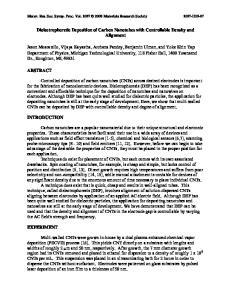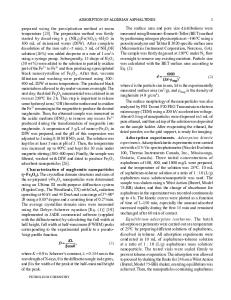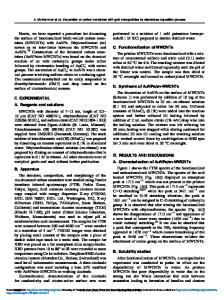Facile Alignment of Carbon Nanotubes Mediated by Tethered Maghemite Nanoparticles
- PDF / 514,815 Bytes
- 6 Pages / 612 x 792 pts (letter) Page_size
- 15 Downloads / 348 Views
1258-R04-05
Facile Alignment of Carbon Nanotubes Mediated by Tethered Maghemite Nanoparticles Il Tae Kim1,2, Grady A. Nunnery1, Karl Jacob2, Justin Schwartz3, Xiaotao Liu3, and Rina Tannenbaum1,4,* 1 Materials Science and Engineering, Georgia Institute of Technology, Atlanta, GA, U.S.A. 2 Polymer, Textile, and Fiber Engineering, Georgia Institute of Technology, Atlanta, GA, U.S.A. 3 Mechanical Engineering, Florida State University, Tallahassee, FL, U.S.A. 4 Chemical Engineering, Technion-Israel Institute of Technology, Haifa, Israel. ABSTRACT We describe a novel, facile method for the alignment of multi-walled carbon nanotubes (MWNTs) in a magnetic field facilitated by the decoration of the MWNTs with monodisperse γFe2 O3 magnetic (maghemite) nanoparticles. The tethering of the nanoparticles was achieved by the attachment of γ-Fe2O3 nanoparticles that were synthesized using a modified sol-gel process, onto the carboxylate-activated MWNTs. Sodium dodecylbenzene sulfonate (NaDDBS) was used to prevent the formation of an iron oxide 3D network. Various characterization methods were employed to confirm the formation of homogeneously-distributed and nearly-monodispersed iron oxide nanoparticles, and show that they were indeed tethered to the walls of the MWNTs. The γ-Fe2O 3 nanoparticles imparted magnetic characteristics to the MWNTs, which in turn, were oriented parallel to the direction of an externally-applied magnetic field. This facile alignment of MWNT could promote the enhancement of various properties, e.g. mechanical and electrical properties, of the resulting composites. Moreover, this facile alignment at low magnetic fields, made possible by the magnetization of the carbon nanotubes through the tethering of maghemite nanoparticles, may be applied to a variety of other useful nanofillers, such a glass fibers, clay nanoparticles and cellulose nanowhiskers. INTRODUCTION Carbon nanotubes (CNTs) have emerged in recent years among the most promising materials for novel applications, due to their unique mechanical, electrical, thermal, and optical properties [1-3]. Because of their nanoscale dimensions and high surface area, CNTs are also considered as efficient templates for the assembly of nanoparticles [4], which allow their functionalization with a variety of nanostructures in two and three dimensions. The decoration of CNTs with various compounds and various structures could increase the tunability of their properties, such as their electrical and magnetic characteristics [5,6]. Recently, various inorganic nanoparticles have been attached to the external surface of CNTs or filled inside CNTs through several experimental methods [7,8]. In this context, the control of the size of these tethered nanoparticles is of primary importance for the purpose of tailoring the physical and chemical properties of these hierarchical materials. Iron oxide nanoparticles such as magnetite and maghemite have been of technological and scientific interest due to their unique electric and magnetic properties. These nanoparticles can b
Data Loading...











